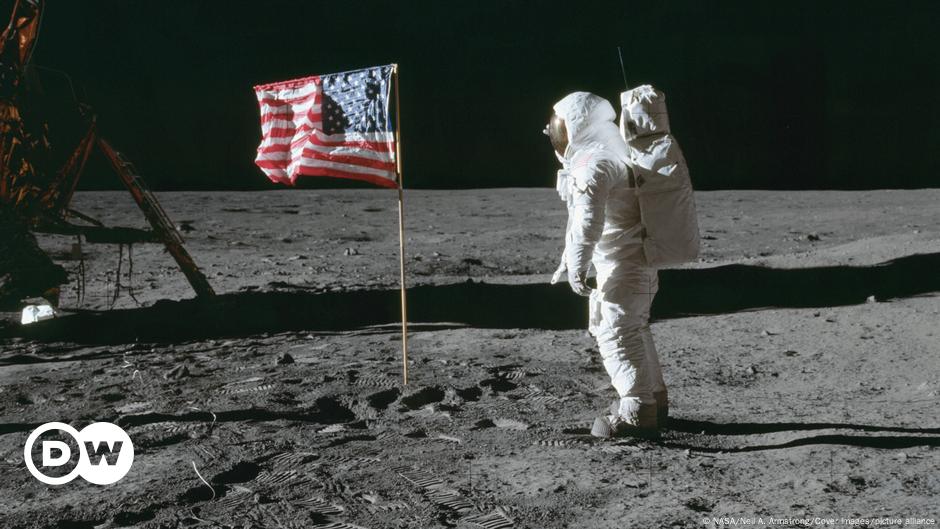Half a century ago, the astronauts of NASA’s Apollo program took A symbol of American patriotism to the moon, immortalized in images of the first humans to set foot on Earth’s natural satellite: the American flag.
In total, six flags were planted on the lunar surface during six successful missions between 1969 and 1972, leaving a visual mark on the history of space exploration. But what happened to these vines over time?
Contrary to what many people think, half of them are still standing despite the relentless lunar environment. It is known by NASA’s Lunar Reconnaissance Orbiter (LRO), which captured images showing the shadows of the flags from the Apollo 12, 16 and 17 missions.
However, not all vines are lucky. The Apollo 11 flag, first raised by Neil Armstrong and Buzz Aldrin on July 20, 1969, appears to have fallen. Aldrin revealed that he saw her fall due to the shock wave from the launch of the lunar module. As for the flags from the Apollo 14 and 15 missions, their fate is uncertain, with images of their current status.
Whitening the vines
Regardless of whether the flags are upright, they are not – if they have been flying for a long time there will be no difference on the surface of the earth. But since the moon has no atmosphere, the effect of time is even greater.
Experts believe that the vines, made of ordinary nylon, have undergone a dramatic change: intense solar radiation may have turned them completely white. Ann Platoff, a librarian and historian at the University of California, Berkeley, said, “Prolonged exposure to sunlight may have caused the vine’s nylon to degrade.” Space.com.
Besides bleaching, vines face other threats. The constant bombardment of micro-meteorites and the extreme temperature fluctuations between lunar day and night can leave the cloth brittle and torn.
Ethical debate
The survival of these symbols raises questions about the preservation of artifacts in space—now, perhaps more than ever, because of renewed interest in lunar exploration, with more than 100 missions planned by 2030.
“The most valuable and vulnerable resource we have on the Moon right now is our history,” warns Michelle Hanlon. Moonkind is for everyoneA non-profit organization dedicated to the preservation of history and human heritage in space.
The Artemis Treaties, signed by 43 countries, recognize the importance of protecting the “heritage of outer space”. However, there are still no specific guidelines on how to protect these historic sites from possible damage from future missions or potential space tourism.
Lunar Sovereignty
Before being planted on lunar soil, the vines were controversial and sparked intense debate about lunar sovereignty.
The decision to plant the American flag on the moon — purchased for just $5.50 at a store in Houston and described by Aldrin as a symbol of the “almost magical unification of all the people of the world at that time” — raised concerns about possible territoriality. The claims are prohibited by the 1967 United Nations Outer Space Treaty. However, pressure from the US Congress prevailed, arguing the need to symbolize the national victory.
“At the time, the question of whether the United States should fly the flag on the moon was very controversial,” said Diesel Muir-Harmony, curator of the Apollo collection at the National Air and Space Museum. Smithsonian Magazine. “But due to Congress pressure, it was decided to hoist the flag on the moon,” he added.
Anne Platoff, in a report to NASA, highlighted how the design of the flagpole allowed the flag to be displayed without wind, a technological innovation that reflected the unique challenges of space engineering. But as Platoff himself pointed out, the act also carried a noble message: America’s presence and influence in space.
“Of course, having an American flag on the surface would not affect the moon’s legal status, but NASA was aware of the international controversy that might arise as a result,” Platoff wrote.
Other objects left behind on the Moon
Apart from flags, astronauts who have already passed by the moon have left behind a variety of objects that tell the story of space exploration.
They range from television cameras that broadcast the first steps on the moon to millions of people to scientific instruments that still work, such as a laser retroreflector that measures the distance between Earth and the moon.
Among the more unusual objects are golf balls, lunar rovers and even human waste.

“Internet addiction in terminals. Award-winning beer expert. Travel expert. General analyst.”







More Stories
Oil falls for 4th consecutive session on US stocks and conflict in Middle East – Money Times
Youth development in UK poultry farming is a new initiative in international production
Robert F. Kennedy Jr. considers abandoning campaign and endorsing Trump